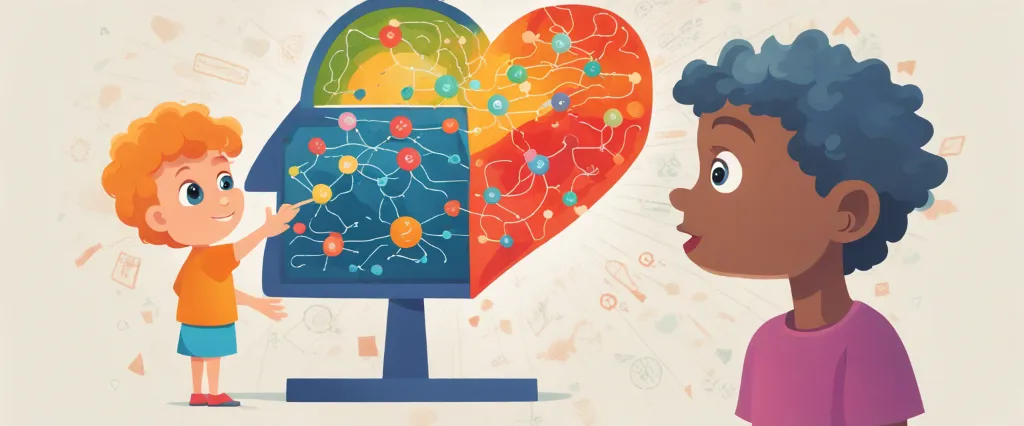
In “The Whole-Brain Child,” Daniel J. Siegel, a renowned clinical psychiatrist and bestselling author, empowers parents with valuable insights into their child’s brain development. Drawing from cutting-edge research in the field of neuroscience, Siegel presents a holistic approach to parenting that acknowledges the intricate connections between a child’s emotional and cognitive development. In this transformative book, Siegel combines scientific knowledge with practical techniques to help parents understand and nurture their child’s whole brain. By leveraging this understanding, parents can foster growth, resilience, and emotional well-being in their children, facilitating healthy brain development that lasts a lifetime.
Chapter 1: The Whole-Brain Child Approach
Chapter 1 of “The Whole-Brain Child” by Daniel J. Siegel introduces the concept of the Whole-Brain Child approach, which focuses on nurturing a child’s brain development by understanding and integrating the various parts of their brain. The chapter begins by emphasizing the importance of parents and caregivers being aware of their child’s brain development in order to successfully navigate through challenging moments and promote healthy emotional growth.
Siegel introduces the metaphor of the “upstairs” and “downstairs” brain to explain the different parts of the brain responsible for different functions. The downstairs brain, comprising the brain stem and limbic system, is responsible for instinctual survival responses and emotional reactions. The upstairs brain, the prefrontal cortex, is involved in higher-order thinking, decision-making, and emotional regulation.
The chapter then explores the impact of stress on the brain and how it can hinder the child’s ability to think and reason effectively. Siegel introduces the concept of “flipping your lid,” explaining how overwhelming emotions can cause the upstairs brain to shut down, leading to impulsive and irrational behavior.
To help children integrate their upstairs and downstairs brain regions, the Whole-Brain Child approach offers several strategies. One technique is called “Name it to Tame it,” where parents help children verbalize and identify their emotions, promoting emotional understanding and regulation. The “Engage, Don’t Enrage” strategy encourages caregivers to empathize with their child’s emotions, avoiding power struggles and approaching conflicts as opportunities for connection and growth.
Lastly, the chapter emphasizes the importance of storytelling to help children make sense of their experiences. Stories engage the brain’s left and right hemispheres, promoting integration and understanding.
Overall, Chapter 1 sets the foundation for the Whole-Brain Child approach by introducing the key concepts of brain development, stress, and strategies for promoting emotional balance and integration in children.
Chapter 2: The Upstairs and Downstairs Brain
Chapter 2: The Upstairs and Downstairs Brain of “The Whole-Brain Child” by Daniel J. Siegel explores the concept of the brain having an “upstairs” and a “downstairs” region, metaphorically representing the different functions and capacities of the brain.
The “downstairs brain” refers to the lower parts of the brain responsible for basic survival functions and instinctual reactions. It consists of the brainstem and limbic system, primarily managing emotions, impulses, and automatic bodily functions. In contrast, the “upstairs brain” refers to the higher, more developed brain regions, particularly the prefrontal cortex, responsible for complex functions such as decision-making, problem-solving, empathy, and self-awareness.
Siegel emphasizes that optimal brain development requires the upstairs and downstairs regions to work in harmony. However, in times of stress or emotional upheaval, the downstairs brain can overpower the upstairs brain, leading to impulsive reactions and impaired judgment. It is essential to understand this imbalance to effectively support children in managing their emotions and developing self-control.
The authors introduce various strategies to help children integrate their upstairs and downstairs brain regions. One such technique is called “name it to tame it,” where parents encourage their children to talk about their emotions, labeling and acknowledging them. This process helps activate the upstairs brain, allowing children to better regulate their emotional responses.
Another strategy is called “engage, don’t enrage.” This involves creating a safe and supportive environment where children feel heard and understood, rather than triggering their downstairs brain by shaming or punishing them. By fostering connection and empathy, parents can help children develop emotional intelligence and problem-solving skills.
Overall, Chapter 2 serves as an important foundation for understanding and nurturing children’s brain development, emphasizing the significance of integrating the upstairs and downstairs brain regions for healthy emotional regulation and overall well-being.
Chapter 3: Integration and the Brain
Chapter 3: Integration and the Brain of “The Whole-Brain Child” by Daniel J. Siegel explores the concept of integration and its importance for the development of a child’s brain. Integration refers to the process of connecting different parts of the brain and creating harmony between them. Siegel emphasizes that a well-integrated brain is crucial for emotional and social well-being.
The chapter begins by introducing the concept of the upstairs and downstairs brain. The downstairs brain, consisting of the brainstem and limbic system, is responsible for basic survival functions and instinctive reactions. The upstairs brain, which includes the prefrontal cortex, is responsible for higher-order thinking, decision making, and emotional regulation. Siegel explains that integration between these two areas is necessary for healthy functioning.
Next, Siegel introduces the concept of the river of integration. Just as a river flows smoothly when all its tributaries are connected and in balance, the brain functions best when all its parts are integrated. When integration is disrupted, either through trauma, stress, or developmental challenges, a child’s emotional and behavioral regulation can be compromised.
The chapter further delves into the critical role that parents and caregivers play in promoting integration. Siegel provides practical strategies for fostering integration, such as connecting with your child, reflecting their feelings, and engaging in playful activities. These techniques help strengthen the connections between different regions of the brain and promote healthy brain development.
Siegel also introduces the concept of mind-sight, which involves understanding one’s own and other people’s mental states. Cultivating mind-sight helps children develop empathy and enhances their ability to connect with others on an emotional level.
In conclusion, Chapter 3 highlights the significance of integration for a child’s brain development and overall well-being. Understanding the importance of integration and implementing practical strategies can help parents and caregivers support their children’s brain development and promote healthier emotional functioning.
Chapter 4: Memory and the Brain

Chapter 4 of “The Whole-Brain Child” by Daniel J. Siegel focuses on the relationship between memory and the brain. The chapter emphasizes how understanding memory can help parents and caregivers support their children’s development.
The chapter begins with a discussion of the three main types of memory: explicit memory, implicit memory, and autobiographical memory. Explicit memory refers to consciously remembering facts or events, while implicit memory is unconscious and includes important skills and habits. Autobiographical memory is the ability to remember personal experiences.
Siegel explains that the brain’s hippocampus plays a crucial role in consolidating and retrieving memories. When events are encoded in a meaningful and emotional context, they are more likely to be remembered. Similarly, the chapter highlights the importance of sleep in memory formation.
The chapter also addresses the impact of trauma on memory, explaining how traumatic experiences can impair memory processing and lead to difficulties in retrieval. Siegel provides strategies to help children integrate their traumatic experiences, such as creating a coherent narrative and engaging in therapeutic activities.
Additionally, the chapter introduces the concept of “reconsolidation,” which involves recalling a memory and then engaging in new experiences to reorganize and update the memory. This process can be beneficial for children who have experienced past trauma or negative memories, as it allows them to create new positive associations.
Siegel offers practical strategies to help children build memory skills, including creating a narrative about their experiences, using visual aids, and storytelling techniques. The chapter also reminds caregivers of the significance of connecting emotions and experiences to enhance memory.
In summary, Chapter 4 of “The Whole-Brain Child” explores the intricate relationship between memory and the brain, emphasizing the importance of emotional context, sleep, and integration of traumatic experiences. It provides strategies for caregivers to support memory development in children, fostering positive associations and healthy memory processing.
Chapter 5: Emotions and the Brain
Chapter 5 of “The Whole-Brain Child” by Daniel J. Siegel dives into the topic of emotions and how they are processed in the brain. The chapter begins by emphasizing the importance of understanding emotions and their impact on a child’s development.
Siegel explains that emotions are an essential part of the human experience, but when they become overwhelming or confusing, they can lead to challenging behaviors. He introduces the concept of “emotional storms,” which are intense emotional reactions that children often undergo. Siegel highlights that these storms are essential opportunities for growth and learning, as they allow children to develop emotional resilience.
The chapter explores two key brain regions involved in emotional processing: the downstairs brain, which encompasses the brainstem and limbic system, and the upstairs brain, specifically the prefrontal cortex. The downstairs brain drives instinctual reactions, while the upstairs brain allows for rational thinking and emotional regulation.
Siegel discusses the importance of integrating these two brain regions and how parents can help their children achieve this integration during emotional storms. He introduces “Name It to Tame It,” a strategy to help children label and verbalize their feelings, which activates the prefrontal cortex, calming the intense emotions originated from the downstairs brain.
Furthermore, the author introduces the concept of “Playfulness,” emphasizing the significance of using playful engagement to communicate with children during challenging emotional moments. This approach helps children feel heard and understood, which strengthens their upstairs brain’s capacity to regulate emotions and self-soothe.
To summarize, Chapter 5 of “The Whole-Brain Child” discusses the importance of understanding emotions and the brain regions involved in emotional processing. It introduces strategies like “Name It to Tame It” and playfulness to help children integrate their downstairs and upstairs brain, thus building emotional resilience and regulation skills.
Chapter 6: Relationships and the Brain
Chapter 6 of “The Whole-Brain Child” by Daniel J. Siegel explores the intricate relationship between the brain and relationships. The chapter highlights how relationships shape and influence a child’s brain development and emotional well-being.
Siegel emphasizes the importance of secure attachment and connection in healthy brain development. When children feel safe and loved, their brains are better equipped to process and regulate emotions effectively. On the other hand, when relationships are disrupted, it can lead to emotional dysregulation and impaired brain functioning. Siegel introduces the concept of “mindsight,” which refers to the ability to understand and reflect on one’s own and others’ minds. Mindsight, developed through nurturing relationships, helps children develop empathy and emotional intelligence.
The chapter delves into the neuroscience behind relationships, focusing on the brain’s mirror neurons. Mirror neurons are responsible for empathy and understanding others’ emotions. Through empathizing with others, children’s mirror neurons fire, mirroring the emotional experience of the person they are connecting with.
Siegel explores how shared joyful experiences and attuned communication foster meaningful connections and neural integration. Attunement involves the ability to empathetically respond to a child’s emotional needs, helping them feel seen and understood. This facilitates neural integration, where different parts of the brain connect and work together harmoniously.
The chapter concludes by discussing how stress and trauma impact relationships and brain development. Stress can disrupt the connections in the brain, hindering proper integration. However, Siegel offers strategies to cultivate resilience and restore balance through secure relationships, emphasizing the power of repairing ruptured connections.
In summary, Chapter 6 of “The Whole-Brain Child” underscores the significance of relationships in shaping a child’s brain development. Secure attachment, empathetic connections, and attuned communication help children develop emotional regulation and resilience. By understanding the neuroscience behind relationships, caregivers can foster healthy brain development and support children’s overall well-being.
Chapter 7: Resilience and the Brain
Chapter 7: Resilience and the Brain of the book The Whole-Brain Child by Daniel J. Siegel explores the topic of resilience and how the brain plays a crucial role in developing this important quality in children. Resilience refers to the ability to adapt and bounce back from challenging or stressful experiences.
The chapter begins by emphasizing the importance of integrating different parts of the brain, specifically the left and right hemispheres, as well as the upstairs and downstairs regions. These integrative processes contribute to the development of resilience. When children face adversity, their brains can become dysregulated, resulting in emotional outbursts or shut down. By guiding them through their challenges, parents can help their children form new connections between different areas of the brain, fostering resilience.
The author introduces the “name it to tame it” strategy, which involves helping children recognize and label their emotions. By doing so, parents can engage the rational thinking part of the brain and help calm the intense emotions generated by the emotional areas of the brain. Additionally, the concept of “replay and review” is discussed. This technique involves discussing challenging situations after they occur, allowing children to reflect on their actions and improve their responses in the face of future hardships.
Furthermore, the chapter discusses the importance of fostering resilience through connection. Siegel highlights the loving relationship between parent and child as a powerful predictor of resilience. By being attuned to their children’s needs and consistently responding with love and understanding, parents can provide a secure attachment that enables children to navigate stress and adversity effectively.
In summary, Chapter 7 explores the connection between resilience and brain development. By integrating different parts of the brain, parents can help their children build resilience. Techniques such as “name it to tame it” and “replay and review” are suggested to foster emotional regulation and reflection. Finally, the chapter emphasizes the significance of a secure parent-child attachment in promoting resilience.

Chapter 8: Applying the Whole-Brain Child Principles
Chapter 8 of the book “The Whole-Brain Child” by Daniel J. Siegel explains how to apply the principles discussed in the previous chapters to promote healthy brain development and better manage challenging behaviors in children.
The chapter begins by emphasizing the importance of integrating the left and right hemispheres of the brain. This integration enables children to think clearly, empathize with others, and develop emotional intelligence. Siegel introduces the concept of “connect and redirect” as a way to engage with children’s emotions during challenging moments. Connecting means empathizing with the child’s feelings and redirecting refers to helping them understand and manage those emotions effectively.
The chapter also highlights the significance of storytelling in facilitating integration. Siegel suggests that parents and caregivers encourage children to tell stories about their experiences, emotions, and challenges. Sharing these stories helps children make sense of their feelings and connect with others emotionally.
Furthermore, Siegel introduces the concept of “mind-sight” as a powerful tool for promoting healthy brain development. Mind-sight involves the ability to see and understand the mind and emotions of oneself and others. The author provides practical exercises and techniques to cultivate mind-sight, such as focusing attention, reflection, and mindfulness practices.
Lastly, the chapter discusses the importance of play as a way for children to develop social skills, emotional regulation, and problem-solving abilities. Siegel suggests that parents and caregivers engage in playful activities that promote integration.
In summary, Chapter 8 of “The Whole-Brain Child” focuses on applying the principles of brain integration, storytelling, mind-sight, and play to help children develop healthy brains and navigate challenging emotions. It provides practical strategies for connecting with children during difficult moments, fostering emotional intelligence, and supporting the development of important life skills.
After Reading
In conclusion, “The Whole-Brain Child” by Daniel J. Siegel offers invaluable insights into the development and nurture of children’s brains. By integrating scientific research with practical strategies, Siegel emphasizes the importance of understanding how different parts of the brain function and communicate with each other. Through stories and examples, he provides parents and caretakers with effective techniques to help children cultivate emotional intelligence, develop self-regulation skills, and thrive in their relationships. This book serves as an empowering guide to fostering healthy brain development, leading to happier and more resilient children.
1. How to Talk So Kids Will Listen & Listen So Kids Will Talk” by Adele Faber and Elaine Mazlish: This classic parenting book provides practical tips and strategies for effective communication with children. It offers valuable insights on building strong relationships, resolving conflicts, and fostering cooperation.
2. No-Drama Discipline: The Whole-Brain Way to Calm the Chaos and Nurture Your Child’s Developing Mind” by Daniel J. Siegel and Tina Payne Bryson: Since you have read “The Whole-Brain Child” by Siegel, his collaboration with Bryson is another excellent choice. This book explores discipline techniques, highlighting the importance of empathetic connection and understanding your child’s brain development.
3. Simplicity Parenting: Using the Extraordinary Power of Less to Raise Calmer, Happier, and More Secure Kids” by Kim John Payne: If you find yourself seeking a more minimalist approach to parenting, this book is invaluable. Payne offers guidance on decluttering, simplifying routines, and creating a peaceful home environment that supports a child’s well-being.
4. The Conscious Parent: Transforming Ourselves, Empowering Our Children” by Dr. Shefali Tsabary: This book challenges traditional parenting paradigms by emphasizing self-awareness and personal growth. Tsabary explores how our own emotional baggage affects our relationships with our children and provides insights on fostering strong connections and nurturing their authentic selves.
5. “Raising an Emotionally Intelligent Child: The Heart of Parenting” by John Gottman and Joan Declaire: Drawing from extensive research on emotional intelligence, this book offers practical tools and exercises to help parents nurture their child’s emotional development. It delves into the importance of empathy, active listening, and healthy communication in building strong parent-child relationships.



